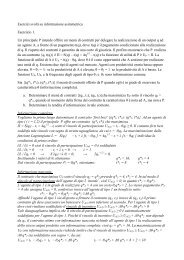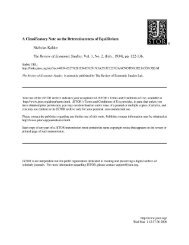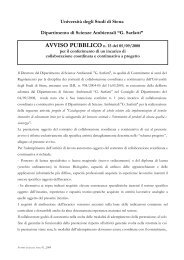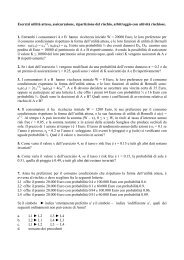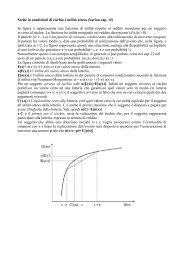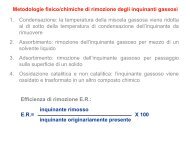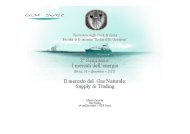A Model of the Trade Cycle Author(s): Nicholas Kaldor Source: The ...
A Model of the Trade Cycle Author(s): Nicholas Kaldor Source: The ...
A Model of the Trade Cycle Author(s): Nicholas Kaldor Source: The ...
- No tags were found...
Create successful ePaper yourself
Turn your PDF publications into a flip-book with our unique Google optimized e-Paper software.
A <strong>Model</strong> <strong>of</strong> <strong>the</strong> <strong>Trade</strong> <strong>Cycle</strong><strong>Author</strong>(s): <strong>Nicholas</strong> <strong>Kaldor</strong><strong>Source</strong>: <strong>The</strong> Economic Journal, Vol. 50, No. 197, (Mar., 1940), pp. 78-92Published by: Blackwell Publishing for <strong>the</strong> Royal Economic SocietyStable URL: http://www.jstor.org/stable/2225740Accessed: 21/04/2008 15:44Your use <strong>of</strong> <strong>the</strong> JSTOR archive indicates your acceptance <strong>of</strong> JSTOR's Terms and Conditions <strong>of</strong> Use, available athttp://www.jstor.org/page/info/about/policies/terms.jsp. JSTOR's Terms and Conditions <strong>of</strong> Use provides, in part, that unlessyou have obtained prior permission, you may not download an entire issue <strong>of</strong> a journal or multiple copies <strong>of</strong> articles, and youmay use content in <strong>the</strong> JSTOR archive only for your personal, non-commercial use.Please contact <strong>the</strong> publisher regarding any fur<strong>the</strong>r use <strong>of</strong> this work. Publisher contact information may be obtained athttp://www.jstor.org/action/showPublisher?publisherCode=black.Each copy <strong>of</strong> any part <strong>of</strong> a JSTOR transmission must contain <strong>the</strong> same copyright notice that appears on <strong>the</strong> screen or printedpage <strong>of</strong> such transmission.JSTOR is a not-for-pr<strong>of</strong>it organization founded in 1995 to build trusted digital archives for scholarship. We enable <strong>the</strong>scholarly community to preserve <strong>the</strong>ir work and <strong>the</strong> materials <strong>the</strong>y rely upon, and to build a common research platform thatpromotes <strong>the</strong> discovery and use <strong>of</strong> <strong>the</strong>se resources. For more information about JSTOR, please contact support@jstor.org.http://www.jstor.org
A MODEL OF TRE TRADE CYCLEl. TRE following pages do not attempt to put forward any" new " <strong>the</strong>ory <strong>of</strong> <strong>the</strong> <strong>Trade</strong> <strong>Cycle</strong>. <strong>The</strong> <strong>the</strong>ory here presentedis essentially similar to alI those <strong>the</strong>ories which explain <strong>the</strong> <strong>Trade</strong><strong>Cycle</strong> as a result <strong>of</strong> <strong>the</strong> combined operation <strong>of</strong> <strong>the</strong> so-called" multiplier " and <strong>the</strong> investment demand function as, e.g., <strong>the</strong><strong>the</strong>ories put forward in recent years by Mr. Harrod and Mr.Kalecki. 1 <strong>The</strong> purpose <strong>of</strong> <strong>the</strong> present paper is to show, bymeans <strong>of</strong> a simple diagrammatic,apparatus, what are <strong>the</strong> necessaryand sufficient assumptions under which <strong>the</strong> combined operation<strong>of</strong> <strong>the</strong>se two forces inevitably gives rise to a cycle.2. <strong>The</strong> baslc principle underlying alI <strong>the</strong>se <strong>the</strong>ories may besought in <strong>the</strong> proposition-a proposition that is really derivedfrom Mr. Keynes' General <strong>The</strong>ory, although not stated <strong>the</strong>re inthis form-that economic activity always tends towards a levelwhere Savings and Investment are equa!. Here <strong>the</strong> termsSavings and Investment are used, <strong>of</strong> course, in a sense differentfrom <strong>the</strong> one according to which <strong>the</strong>y are always and necessarilyequal-in <strong>the</strong> ex-ante, and not <strong>the</strong> ex-post sense. Investmentex-ante is <strong>the</strong> value <strong>of</strong> <strong>the</strong> designed increments <strong>of</strong> stocks <strong>of</strong> alIkinds (i.e., <strong>the</strong> value <strong>of</strong> <strong>the</strong> net addition to stocks plus <strong>the</strong> value<strong>of</strong> <strong>the</strong> aggregate output <strong>of</strong> fixed equipment), which differs fromInvestment ex-post by <strong>the</strong> value <strong>of</strong> <strong>the</strong> undesigned accretion (ordecumulation) <strong>of</strong> stocks. Savings ex-ante is <strong>the</strong> amount peopleintend to save-i.e., <strong>the</strong> amount <strong>the</strong>y actually would save if <strong>the</strong>ycorrectly forecast <strong>the</strong>ir incomes. Hence ex-ante and ex-postSaving can differ only in so far as <strong>the</strong>re is an unexpected changein <strong>the</strong> amount <strong>of</strong> incorne earned.If ex-ante Investment exceeds ex-ante Saving, ei<strong>the</strong>r ex-postInvestment will fall short <strong>of</strong> ex-ante Investment, or ex-post Savingwill exceed ex-ante Saving; and both <strong>the</strong>se discrepancies willinduce an expansion in <strong>the</strong> level <strong>of</strong> activity. If ex-ante Investmentfalls short <strong>of</strong> ex-ante Saving ei<strong>the</strong>r ex-post Investment willexceed ex-ante Investment, or ex-post Saving will fall short <strong>of</strong>ex-ante Saving, and both <strong>the</strong>se discrepancies will induce a contraction.This must be so, because a reduction in ex-post Savingas compared with ex-ante Saving will make consumers spend lesson consumers' goods, an excess <strong>of</strong> ex-post Investment over ex-ante~1 Harrod, <strong>The</strong> <strong>Trade</strong> Oycle,. Kalecki, "A <strong>The</strong>ory <strong>of</strong> <strong>the</strong> Business <strong>Cycle</strong>,"Review oJ Economie Studies, February 1937, reprinted in Essays in <strong>The</strong>ory oJEconomic Fluctuations.
MAROH 1940] A MODEL OF TRE TRADE OYOLE 79Investment (implying as it does <strong>the</strong> accretion <strong>of</strong> unwanted stocks)will cause entrepreneurs to spend less on entrepreneurial goods;while <strong>the</strong> total <strong>of</strong> activity is always determined by <strong>the</strong> sum <strong>of</strong>consumers' expenditures and entrepreneurs' expenditures. Thusa discrepancy between ex-ante Saving and ex-ante Investmentmust induce a change in <strong>the</strong> level <strong>of</strong> activity which proceeds until<strong>the</strong> discrepancy is removed.3. <strong>The</strong> magnitudes df both ex-ante Saving and ex-ante Investmentare <strong>the</strong>mselves functions <strong>of</strong> <strong>the</strong> level <strong>of</strong> activity, and bothvary positively with <strong>the</strong> level <strong>of</strong> activity. Thus if we denote <strong>the</strong>level <strong>of</strong> activity (measured in terms <strong>of</strong> employment) by x, bothSand I (ex-ante Savings and Investment) will be single-valuedfunctions <strong>of</strong> x 1 and both ~~ and ~~ will be positive.<strong>The</strong> first<strong>of</strong> <strong>the</strong>se expresses <strong>the</strong> basic principle <strong>of</strong> <strong>the</strong> "multiplier" (that<strong>the</strong> marginal/propensity to consume is less than unity),2 and <strong>the</strong>second denotes <strong>the</strong> assumption that <strong>the</strong> demand for capitaI goodswill be greater <strong>the</strong> greater <strong>the</strong> level <strong>of</strong> production. 3If we regard <strong>the</strong> S(x) and I(x) functions as linear, as in <strong>the</strong>absence <strong>of</strong> fur<strong>the</strong>r information one is inclined to do, we have twopossibilities :-(i) ~~ exceeds ~~, in which case, as shown by Fig. 1,4 <strong>the</strong>recan be only a single position <strong>of</strong> unstable equilibrium, since above1 Sand I are, <strong>of</strong> course, both functions <strong>of</strong> <strong>the</strong> rate <strong>of</strong> interest in addition to<strong>the</strong> level <strong>of</strong> activity. But <strong>the</strong> rate <strong>of</strong> interest, at any rate in <strong>the</strong> first approximation,could itself be regarded as a single valued function <strong>of</strong> <strong>the</strong> level <strong>of</strong> activity,and thus its infiuence incorporated in <strong>the</strong> S(x) and I(x) functions. (It is notnecessary to assume, in order that:; should be positive, that <strong>the</strong> rates <strong>of</strong> interest-short and long term-are constant. We can aHow for some variation as <strong>the</strong>ratés' <strong>of</strong> interest, to be associated with a change in investment and incomes, providedthis variation is not large enough to prevent <strong>the</strong> change in incomes altoge<strong>the</strong>r.AH that we are excluding here is a banking policy which so regulatesinterest rates as to keep <strong>the</strong> level <strong>of</strong> incomes constant.)2 :~ is, <strong>of</strong> course, <strong>the</strong> reciprocal <strong>of</strong> Mr. Keynes' investment multiplier, which. l dO dS18 defined as l _ dC' where dX = l - dX'dx3 This assumption should not be confused with <strong>the</strong> " acceleration principle "(<strong>of</strong> Pr<strong>of</strong>. J. M. Clark and o<strong>the</strong>rs), which asserts that <strong>the</strong> demand for capitaI goodsis a function <strong>of</strong> <strong>the</strong> rate oj change <strong>of</strong> <strong>the</strong> level <strong>of</strong> activity, and not <strong>of</strong> <strong>the</strong> level <strong>of</strong>activity itself. <strong>The</strong> <strong>the</strong>ory put forward below is thus not based on this " accelera·tion principle" (<strong>the</strong> generaI validity <strong>of</strong> which is questionable), but on a muchsirnpler assumption-i.e., that an increase in <strong>the</strong> current level <strong>of</strong> pr<strong>of</strong>its increasesinvestment demando4 In Fig. l, as in aH subsequent diagrams, <strong>the</strong> level <strong>of</strong> activity is measuredalong Ox and <strong>the</strong> corresponding value <strong>of</strong> ex-ante Investment and Saving along Oy.
80 TRE ECONOMIC JOURNAL [MARCH<strong>the</strong> equilibrium point 1>8, and thus activity tends to expand,below it S >1, and hence it tends to contract. If <strong>the</strong> Sand 1functions were <strong>of</strong> this character, <strong>the</strong> economic system wouldalways be rushing ei<strong>the</strong>r towards a state <strong>of</strong> hyper-inflation withfull employment, or towards a state <strong>of</strong> complete collapse withzero employment, with no resting-place in between. Sincerecorded experience does not bear out such dangerous instabilities,this possibility can be dismissed.yoFIG. l.x(ii) ~~ exceeds ~~, in which case, as shown in Fig. 2, <strong>the</strong>rewill be a single position <strong>of</strong> stable equilibrium. (This, I believe,is <strong>the</strong> assumption implied in Mr. Keynes' <strong>the</strong>ory <strong>of</strong> employment.)If <strong>the</strong> economic system were <strong>of</strong> this nature, ,any disturbance,originating ei<strong>the</strong>r on <strong>the</strong> investment side or on <strong>the</strong> savings side,yso s FIG. 2.xwould be followed by <strong>the</strong> re-establishment <strong>of</strong> a new equilibrium,with a stable level <strong>of</strong> activity.l Hence this assumption fails in <strong>the</strong>opposite direction: it assumes more stability than <strong>the</strong> real worldappears, in fact, to ,possesso AIso, if <strong>the</strong>re is any justification in<strong>the</strong> contention <strong>of</strong> <strong>the</strong> "accelerationists," <strong>the</strong> possibility <strong>of</strong> ~~1 Except in so far as <strong>the</strong> existence <strong>of</strong> time.lags <strong>of</strong> adjustment might prevent,on certain assumptions, <strong>the</strong> new equilibrium from being reached. Cf. Appendixbelow.
1940] A MODEL OF THE TRADE OYOLE 81being greater than ~~' at any rate for certain values <strong>of</strong> x, cannotbe excluded.For ~~ could be many times greater than dx, while~~ can never be more than a fraction <strong>of</strong> dx.4. Since thus nei<strong>the</strong>r <strong>of</strong><strong>the</strong>se two assumptions can be justified,we are left with <strong>the</strong> conclusion that <strong>the</strong> I(x) and S(x) functionscannot both be linear, at any rate over <strong>the</strong> entire·range. And, infact, on closer examination, <strong>the</strong>re are good reasons for supposingthat nei<strong>the</strong>r <strong>of</strong> <strong>the</strong>m is lineare(a) In <strong>the</strong> case <strong>of</strong> <strong>the</strong> investment function it is probable that~~ will be 81'IUJ,ll, both for low and for high levels <strong>of</strong> x, relativelyto its " normal "level.yIt will be small for low levels <strong>of</strong> activityoFIG. 3.·xbecause when <strong>the</strong>re is a great deal <strong>of</strong> surplus capacity, an increasein activity will not induce entrepreneurs to undertake additional-construction: <strong>the</strong> rise in pr<strong>of</strong>its will not stimulate investment.(At <strong>the</strong> same time, <strong>the</strong> level <strong>of</strong> investment will not be zero, for<strong>the</strong>re is always some investment undertaken for long-perioddevelopment purposes which is independent <strong>of</strong> current activity.)But it wili also be small for unusllally high levels <strong>of</strong> activity,because rising costs <strong>of</strong>construction, increasing costs and increasingdifficulty <strong>of</strong> borrowing will dissuade entrepreneurs from expandingstili faster-at a time when <strong>the</strong>y aIready have large commitments.Hence, given some "normal " value <strong>of</strong> ~~' appropriatefor "normal " levels <strong>of</strong> activity, <strong>the</strong> I(x) function will deviatefrom linearity in <strong>the</strong> manner suggested in Fig. 3.(b) In <strong>the</strong> case <strong>of</strong> <strong>the</strong> savings function, <strong>the</strong> situation appearsto be exactly <strong>the</strong> o<strong>the</strong>r way round: ~~ is likely to be relativelylarge, both for low and high levels <strong>of</strong> activity, as compared withits normallevel. When incomes are unusually low, savings are cutNo. 197.-VOL. L.G
82 TRE ECONOMIC JOURNAL [MARCHdrastically, and below a certain level <strong>of</strong> incorne <strong>the</strong>y will benegative. When incornes are unusually high, people are likely tosave not only a higher amount, but also a larger proportion <strong>of</strong><strong>the</strong>ir income.! <strong>The</strong>se tendencies, for society as a whole, arelikely to be reinforced by <strong>the</strong> fact that when activity is at a lowlevel, an increasing proportion <strong>of</strong> workers' earnings are paid out<strong>of</strong> capitaI funds (in <strong>the</strong> form <strong>of</strong> unemployment benefits); whilewhen activity is at a high level, prices will tend to rise relativelyto wages, <strong>the</strong>re will be a shift in <strong>the</strong> distribution <strong>of</strong> incomes infavour <strong>of</strong> pr<strong>of</strong>its, and thus an increase in <strong>the</strong> aggregate propensityto save.Rence ~~ will deviate from its normal level in <strong>the</strong>manner suggested in Fig. 4.yoFIG. 4.In what follows it· will be assumed that <strong>the</strong> two functionsconform to <strong>the</strong>se criteria. But, as <strong>the</strong> reader will note, ouranalysis would remain valid even if on:ly one oj <strong>the</strong> two functionsbehaved in <strong>the</strong> manner suggested, while <strong>the</strong> o<strong>the</strong>r was lineare5. Given <strong>the</strong>se assumptio11S about <strong>the</strong> behaviour <strong>of</strong><strong>the</strong> savingsand investment functions, and assuming fur<strong>the</strong>r that <strong>the</strong> normalvalue <strong>of</strong> ~~ is greater than <strong>the</strong> normal value <strong>of</strong> ~~, <strong>the</strong> situationwill be one <strong>of</strong> multiple equilibria, as shown in Fig. 5. A and B(in <strong>the</strong> diagram) are both stable positions, for at points belowA or B, 1>8, hence activity tends to expand; above it 8 >1, hellceactivity tends to contract. ° is an unstable position in bothdirections, and hence not a possible position <strong>of</strong> equilibrium. <strong>The</strong>significance <strong>of</strong> point °is simply that if activity happens to beabove 0, <strong>the</strong>re will be a process <strong>of</strong> expansion which will come to ahalt at B; if it happens to be below 0, <strong>the</strong>re will be a process <strong>of</strong>contraction until equilibrium is reached at A. .1 Thus <strong>the</strong>re is something like a " customary standard <strong>of</strong> Iiving" based on<strong>the</strong> " normallevel " <strong>of</strong> incomes, and, corresponding to it, <strong>the</strong>re is a certain normalrate <strong>of</strong> savings. If incomes are much beIow it, individuais will attempt to maintain<strong>the</strong>ir standard <strong>of</strong> living by consuming capitaI; if incomes are much above it,<strong>the</strong>y will tend to save a disproportionate amount.x
1940] A MODEL OF TRE TRADE CYCLE 83Hence <strong>the</strong> economic system can reach stability ei<strong>the</strong>r at acertain high rate <strong>of</strong> activity or at a certain low rate <strong>of</strong> activity.<strong>The</strong>re will be a certain depression level and a certain prosperitylevel at which it <strong>of</strong>fers resistance to fur<strong>the</strong>r changes in ei<strong>the</strong>rdirection. <strong>The</strong> key to <strong>the</strong> explanation <strong>of</strong> <strong>the</strong> <strong>Trade</strong> <strong>Cycle</strong> is tobe found in <strong>the</strong> fact that each <strong>of</strong> <strong>the</strong>se two positions is stable onlyin <strong>the</strong> short period: that as activity continues at ei<strong>the</strong>r one <strong>of</strong><strong>the</strong>se Ievels, forces gradually accumulate which sooner or Iaterwill render that particular position unstable. It is to an explanation<strong>of</strong> <strong>the</strong> nature <strong>of</strong> <strong>the</strong>se forces that we must now turno6. Both S(x) and I(x) are "short-period" functions-i.e.,<strong>the</strong>y assume <strong>the</strong> total amount <strong>of</strong> fixed equipment in existence,and hence <strong>the</strong> amount <strong>of</strong> real income at an~ particular Ievel <strong>of</strong>ySBFIG. 5.xactivity, a~ given. As <strong>the</strong>se factors change in time, <strong>the</strong> Sand Icurves wiII shift <strong>the</strong>ir position; but according as activity is highor low (equilibrium is at B or at A) <strong>the</strong>y will shift in differentways.(i) When activity is high (equilibrium at B), <strong>the</strong> Ievel <strong>of</strong>investment is high, <strong>the</strong> total amount <strong>of</strong> equipment gradualIyincreases, and so, in consequence, <strong>the</strong> amount <strong>of</strong> consumers' goodsproduced at a given level <strong>of</strong> activity. As a result <strong>the</strong> S Cllrvegradually shifts upwards (for <strong>the</strong>re will be more consumption,and hence more saving, for any given activity); for <strong>the</strong> samereason <strong>the</strong> I curve gradually falls. (<strong>The</strong> accumulation <strong>of</strong> capitaI,by restrictin.g <strong>the</strong> range <strong>of</strong> available investment opportunities,will tend to make it. fall, while new inventions tend, on <strong>the</strong> whole,to make it rise. But <strong>the</strong> first <strong>of</strong> <strong>the</strong>se factors is bound to be morepowerful after a time.) As a result, <strong>the</strong> position <strong>of</strong> B is graduallyshifted to <strong>the</strong> left and that <strong>of</strong> O to <strong>the</strong> right, thus reducing <strong>the</strong>level <strong>of</strong> activity somewhat and bringing Band O nearer to eacho<strong>the</strong>r (see Fig. 6, " Stage II ").
84 TRE ECONOMIC JOURNAL [MARCH<strong>The</strong> criticaI point is reached when, on account <strong>of</strong> <strong>the</strong>se movements,<strong>the</strong> I and S curves become tangential and <strong>the</strong> pointsBand O faII toge<strong>the</strong>r (" Stage III "). At that point equilibriumbecomes unstable in a downward direction, since in <strong>the</strong> neighbourhood<strong>of</strong> <strong>the</strong> point S >1 in both directions. <strong>The</strong> Ievel <strong>of</strong> activitywill now faII rapidly, on account <strong>of</strong> <strong>the</strong> excess <strong>of</strong> ex-ante Savingsover ex-ante Investment, until a new equilibrium is reached at Awhere <strong>the</strong> positioIi is again stable. 1 , 2(ii) _When activity is Iow, <strong>the</strong> movement <strong>of</strong> <strong>the</strong> 1 and S curveswill tend to be in <strong>the</strong> opposite direction. For if at <strong>the</strong> Ievel <strong>of</strong>investment corresponding to A investment is not sufficient tocover replacement, so that net investment in industriaI pIant andequipment is negative,3 investment opportunities gradually1 <strong>The</strong> route followed in <strong>the</strong> transition from B to A might be ei<strong>the</strong>r along <strong>the</strong>I curve or <strong>the</strong> S curve, according to whe<strong>the</strong>r ex-post Saving is adjusted to ex-anteInvestment, or ex-post Investment to ex-ante Saving-i.e., according as <strong>the</strong>disappointment <strong>of</strong> expectations occurs on <strong>the</strong> side <strong>of</strong> incomes, or in <strong>the</strong> level <strong>of</strong>entrepreneurial stocks.2 <strong>The</strong> fall in <strong>the</strong> rate <strong>of</strong> activity during <strong>the</strong> transition need not be very rapid,and may even take some years. This is because both entrepreneurs and con·sumers take some time to adjust <strong>the</strong>ir scale <strong>of</strong> purchases to <strong>the</strong>ir changed rate <strong>of</strong>earnings. If <strong>the</strong> process is at all prolonged, <strong>the</strong> two curves will be back at <strong>the</strong>ir"normal" position (as shown in Fig. 5 or " Stage IV " in Fig. 6) by <strong>the</strong> timepoint A is reached.3 It is not necessary, <strong>of</strong> course, that total net investment should be negative,since investment can take forms (such as armaments, etc.) whose constructiondoes not reduce <strong>the</strong> available opportunities for <strong>the</strong> future.
1940] A MODEL OF THE TRADE CYCLE 85accumulate and <strong>the</strong> I curve will shift upwards; and this tendencyis likely to be reinforced by new inventions. For <strong>the</strong> same reason,<strong>the</strong> graduaI decumulation <strong>of</strong> capitaI, in so far as it causes realincome per unit <strong>of</strong> activity to fall, willlower <strong>the</strong> S curve.! <strong>The</strong>semovements cause <strong>the</strong> position <strong>of</strong> A to shift to <strong>the</strong> right and that<strong>of</strong>. G to shift to <strong>the</strong> left (thus separating Band C ànd bringingA and C nearer to each o<strong>the</strong>r), involving a graduaI improvementin <strong>the</strong> level <strong>of</strong> activity (Stages IV and V). This will proceeduntil A and G fall toge<strong>the</strong>r (<strong>the</strong> two curves again become tangential),when a new criticaI situation is reached; <strong>the</strong> positionbecomes unstable in an upward direction, since I >S on ei<strong>the</strong>rside <strong>of</strong> <strong>the</strong> equilibrium point; an upward cumulative movementwill follow which can only come to rest when position B is reached(Stage VI). <strong>The</strong>reafter <strong>the</strong> curves gradually return to <strong>the</strong>position shown in Stage I, and <strong>the</strong> cyclical movement isrepeated.7. <strong>The</strong> necessary and sufficient assumptions under which <strong>the</strong>combined operation <strong>of</strong> <strong>the</strong> saving and investment functions inevitablygenerate a èyclical movement which nowhere tends tocome to rest, can <strong>the</strong>refore be set out as follows :-(l) <strong>The</strong> "normal value" <strong>of</strong> ~;, valid for normal levels <strong>of</strong>activity, must'be greater than <strong>the</strong> corresponding value <strong>of</strong>~~.(2) <strong>The</strong> "extreme values" <strong>of</strong> ~~, valid for abnormally highor abnormally low levels <strong>of</strong> activity, must be smaller than <strong>the</strong>corresponding values <strong>of</strong> ~~.(3) <strong>The</strong> level <strong>of</strong> investment at <strong>the</strong> upper equilibrium paintmust be sufficiently large for <strong>the</strong> I(x) function to JaZZ (in time)relatively to <strong>the</strong> S(x) function; and at <strong>the</strong> lower equilibrium pointit must be sufficiently small for <strong>the</strong> I(x) function to rise (in time)relatively to <strong>the</strong> S(x) function.In o<strong>the</strong>r words, <strong>the</strong> position <strong>of</strong>zero' net investment must fall within <strong>the</strong> limits set by <strong>the</strong> levels<strong>of</strong> investment ruling at B + C and A +. C, in Stage III andStage VI, respectively.If condition (1) did not obtain, equilibrium at C (which is infact <strong>the</strong> " normal " equilibrium position) would be stable, instead1 It is possible that even if net investment is negative, real output per headshould gradually rise in time (on account <strong>of</strong> <strong>the</strong> introduction <strong>of</strong> superior or more" capitalistic " processes <strong>of</strong> production during <strong>the</strong> depression), as a result <strong>of</strong> whichS would tend to rise ra<strong>the</strong>r than falle But this makes no difference so long as <strong>the</strong>I curve rises faster than <strong>the</strong> S curve.
86 THE ECONOMIC JOURNAL [MARCH<strong>of</strong> unstable; equilibrium would tend to get established <strong>the</strong>re, and,once established, <strong>the</strong> shifts in <strong>the</strong> I and S curves, due to capitaIaccumulation or decumulation, would merely lead to graduaIchanges in <strong>the</strong> level <strong>of</strong> activity unti! a position <strong>of</strong> stationarinessis reached; <strong>the</strong>y would not generate cyclical movements. Ifcondition (2) was not satisfied (at any rate as regards low levels <strong>of</strong>activity) 1 <strong>the</strong> system, as we have seen, would be so unstable thatcapitalism could not function at alI. Finally, if condition (3) didnot obtain, <strong>the</strong> cyclical movements would come to a halt at somestage, owing to a cessation <strong>of</strong> <strong>the</strong> movements <strong>of</strong> <strong>the</strong> S(x) andI(x) functions.This is not to suggest that in <strong>the</strong> absence <strong>of</strong> <strong>the</strong>se three conditionscyclical phenomena would be aItoge<strong>the</strong>r impossibIe.Only <strong>the</strong>y would have to be explained with <strong>the</strong> aid <strong>of</strong> differentprinciples; <strong>the</strong>y could not be accounted for by <strong>the</strong> savings andinvestment functions alone.8. In fact, conditions (1) and (2) are almost certain to besatisfied in <strong>the</strong> real world; doubt could only arise in connectionwith condition (3). It can be taken for granted, <strong>of</strong> course, thatnet investment will be positive while equilibrium is at position B;but it is by no means so certain that net investment will benegative while equilibr:ium is at position A.2 It is quite possible,for example, that savings should fall rapidly at a relatively earlystage <strong>of</strong> <strong>the</strong> downward movement, so that position A is reachedwhile net investment is stilI positive. In that case <strong>the</strong> Sand Icurves will stilI move in <strong>the</strong> same direction as at B, with <strong>the</strong> resultthat <strong>the</strong> position A is gradually shifted to <strong>the</strong> left, until netinvestment becomes zero. At that point <strong>the</strong> moven'lents <strong>of</strong> <strong>the</strong>I and S curves will cease; <strong>the</strong> forces making for expansion orcontractiQn come to a standstill. Alternatively, we might assumethat net investment at A is initially negative, but in <strong>the</strong> course <strong>of</strong><strong>the</strong> graduaI improvement, <strong>the</strong> position <strong>of</strong> zero net investment isreached before <strong>the</strong> forces <strong>of</strong> cumulative expansion couId come intooperation-i.e., somewhere during Stages IV and V, and before<strong>the</strong> cycle r:eaches Stage VI. In this case, too, <strong>the</strong> cyclical movementwill get into a deadlock.1 It is possible that <strong>the</strong> point B should be situated beyond <strong>the</strong> position <strong>of</strong> fullemployment-i.e., that in <strong>the</strong> course <strong>of</strong> <strong>the</strong> upward movement <strong>the</strong> state <strong>of</strong> fullemployment should be reached befolfe ex-ante Savings and Investment reachequality. In that case <strong>the</strong> upward movement would end in a state <strong>of</strong> cumulativeinflation, which in turn would, sooner or later, be brought to a halt by a rise ininterest rates sufficient to push <strong>the</strong> point B inside <strong>the</strong> full-employment barrier.From <strong>the</strong>n onwards <strong>the</strong> cyclical movement would proceed in exactly <strong>the</strong> samemanner as described.2 <strong>The</strong> term " net investment " here is used in <strong>the</strong> sense defined in § 6 (ii).
1940] A MODEL OF THE TRADE CYCLE 87Hence <strong>the</strong> forces making for expansion when we start from astate <strong>of</strong> depression are not so certam in <strong>the</strong>ir operation as <strong>the</strong>forces making for a down-turn when we start from prosperity;<strong>the</strong> danger <strong>of</strong> chronic stagnation is greater than <strong>the</strong> danger <strong>of</strong> achronic boom. A boom, if left to itself, is certain to come to anend; but <strong>the</strong> depression might get into a position <strong>of</strong> stationariness,and remain <strong>the</strong>re until external changes (<strong>the</strong> discovery <strong>of</strong> newinventions or <strong>the</strong> opening up <strong>of</strong> new markets) come to <strong>the</strong> rescue.9. <strong>The</strong> preceding analysis <strong>of</strong>fers also certain indicationsregarding <strong>the</strong> determination <strong>of</strong> t~e period and <strong>the</strong> amplitude <strong>of</strong><strong>the</strong> <strong>Cycle</strong>. <strong>The</strong> period <strong>of</strong> <strong>the</strong> Oycle seems to depend on two timelags,or ra<strong>the</strong>r time-rates <strong>of</strong> movement: (i) on <strong>the</strong> rate at which<strong>the</strong> Sand Icurves shift at any particular level <strong>of</strong> investment(this, <strong>of</strong> course, will vary with <strong>the</strong> level <strong>of</strong> investment, and willbe faster when investment is high or low, than in <strong>the</strong> middle);(ii) on <strong>the</strong> time taken to complete a ,t' cumulative movement "i.e., <strong>the</strong> time required for <strong>the</strong> system to travel from B + O to Aor from A + O to B (Stages III and VI).<strong>The</strong> second <strong>of</strong> <strong>the</strong>se factors obviously depends on <strong>the</strong> velocitywith which entrepreneurs and consumers adjust <strong>the</strong>ir expectationsand thus <strong>the</strong>ir buying-plans to unexpected changes in <strong>the</strong> situation.<strong>The</strong> first factor, on <strong>the</strong> o<strong>the</strong>r hand, seems to depend on technicaldata, on <strong>the</strong> construction period and durability <strong>of</strong> capitaI goods.<strong>The</strong> shorter <strong>the</strong> construction period, <strong>the</strong> greater will be <strong>the</strong> output<strong>of</strong> capitaI goods, per unit' period, at a given rat~ <strong>of</strong> investment;<strong>the</strong> shorter <strong>the</strong> life-tjme <strong>of</strong> capitaI goods, <strong>the</strong> larger willbe <strong>the</strong> percentage addition to total equipment represented by agiven output <strong>of</strong> capitaI goods. Hence <strong>the</strong> shorter <strong>the</strong> construction-period,and <strong>the</strong> lower <strong>the</strong> durability, <strong>the</strong> faster will be <strong>the</strong>rate <strong>of</strong> Sllift <strong>of</strong> <strong>the</strong> Sand I curves at any given rate <strong>of</strong> investment;<strong>the</strong> shorter <strong>the</strong> length <strong>of</strong> <strong>the</strong> <strong>Trade</strong> <strong>Cycle</strong>. 1As regards <strong>the</strong> amplitude, this depends on <strong>the</strong> shapes <strong>of</strong> <strong>the</strong>I and S curves, which determine <strong>the</strong> distance between A and B,at <strong>the</strong>ir "normal" position (i.e., at Stages I and IV). <strong>The</strong>amplitude will be alI <strong>the</strong> smaller <strong>the</strong> shorter <strong>the</strong> range <strong>of</strong> activityover which <strong>the</strong> "normal values" <strong>of</strong> ~~ and ~~ are operative.1 If <strong>the</strong> " capitaI intensity " <strong>of</strong> investments varies in <strong>the</strong> different phases <strong>of</strong><strong>the</strong> CycIe in an inverse relation to <strong>the</strong> rate <strong>of</strong> investment (i.e., is less in boomperiods than in depression periods), this will tend to reduce <strong>the</strong> period <strong>of</strong> <strong>the</strong>CycIe, as compared with a situation where <strong>the</strong> capitaI intensity is constant, sinceit will increase <strong>the</strong> rate <strong>of</strong> shift <strong>of</strong> <strong>the</strong> Sand I curves. ConverseIy, if capitaIintensity varied in direct relation with <strong>the</strong> rate <strong>of</strong> investment, this wouId Ieng<strong>the</strong>n<strong>the</strong> periodo Finally, if capitaI intensity showed a steady increase throughout <strong>the</strong>CycIe, this wouId Ieng<strong>the</strong>n <strong>the</strong> boom periods and shorten <strong>the</strong> depression periods.
88 TRE ECONOMIC JOURNAL [MAROHVariations in <strong>the</strong> amplitude <strong>of</strong> successive cycles, 011 <strong>the</strong> o<strong>the</strong>rhand, seem to depend entirely on extraneous factors, such as newillventions or secular changes ·in habits <strong>of</strong> saving. <strong>The</strong>re appearsto be no necessary reason why, in <strong>the</strong> absen.ce <strong>of</strong> such factors, tlleamplitude should be gradually decreasing or vice-versa.!lO. Our model should also enable us to throw some light onproblems <strong>of</strong> economic policy. Rere I confine myself to twopoints. (i) It appears that measures taken to combat <strong>the</strong>depression (through public investment) have much more chance<strong>of</strong> success if taken at a relatively early stage, or at a relatively latestage, than at <strong>the</strong> bottom <strong>of</strong> <strong>the</strong> depressione If taken early, <strong>the</strong>problem is merely to prevent that graduaI fall in <strong>the</strong> investmentfunction relatively to <strong>the</strong> saving function which carries <strong>the</strong> cyclefrom Stage II to Stage III. But, once Stage III is passed, nothingcan prevent <strong>the</strong> switch-over from <strong>the</strong> B-equilibrium to <strong>the</strong> Aequilibrium, and <strong>the</strong>n <strong>the</strong> problenl becomes one <strong>of</strong> raising <strong>the</strong>investment demand schedule sufficiently to lift <strong>the</strong> position toStage VI (at which <strong>the</strong> forces <strong>of</strong> expansion come into operation).<strong>The</strong> amount <strong>of</strong> public investment required to achieve this isobviously much greater in <strong>the</strong> early phase <strong>of</strong> <strong>the</strong> depression (atStage IV) than in <strong>the</strong> later phase (at Stage V). Thus just when<strong>the</strong> depression is at its worst <strong>the</strong> difficulty <strong>of</strong> overcoming it is <strong>the</strong>greatest. (ii) <strong>The</strong> chances <strong>of</strong> "evening out" fiuctuations by" anti-cyclical " public investment appear to be remote. For if<strong>the</strong> policy is successful in preventing <strong>the</strong> downward cumulativemovement, it will also succeed in keeping <strong>the</strong> level <strong>of</strong> privateinvestment high; and for this very reason <strong>the</strong> forces making fora down-turn will continue to accumulate, thu;s making <strong>the</strong> needfor continued public investment greater. Thus, if, on <strong>the</strong> basis<strong>of</strong> past experience, <strong>the</strong> Government <strong>Author</strong>ity contemplates afour years public investment pIan, in <strong>the</strong> beliefthat <strong>the</strong>reby it canbridge <strong>the</strong> gap between one prosperity-period and <strong>the</strong> ne~t, it ismore likely that it might succeed in postponing <strong>the</strong> onset <strong>of</strong> <strong>the</strong>1 At first sight one might think that this question aiso depends on endogenousfactors: that <strong>the</strong> cycle will be "damped" (amplitude <strong>of</strong> successive cyclesdecreasing) if <strong>the</strong> point <strong>of</strong> zero net investment is so situated that <strong>the</strong>re will be netcapitaI accumulation over <strong>the</strong> cycle as a whole, and vice versa. But this is notso. If <strong>the</strong>re is net accumulation over <strong>the</strong> cycle as a whole (i.e., <strong>the</strong> accumulationover <strong>the</strong> boom period exceeds <strong>the</strong> decumulation during <strong>the</strong> depression), <strong>the</strong>n, in<strong>the</strong> absence <strong>of</strong> extraneous changes, <strong>the</strong> position B at <strong>the</strong> corresponding stages <strong>of</strong>successive cycles will be situated more and more to <strong>the</strong> Ieft; but <strong>the</strong> position Awill aiso be situated more to <strong>the</strong> Ieft, with <strong>the</strong> result that, though <strong>the</strong>re will be agraduaI fall in <strong>the</strong> average Ievei <strong>of</strong> activity, <strong>the</strong>re need be no decrease in <strong>the</strong>deviations around <strong>the</strong> average. <strong>The</strong> same holds, mutatis mutandis, if <strong>the</strong>re isnet decumulation over <strong>the</strong> cycle as a whole.
1940] A MODEL OF THE TRADE CYCLE 89depression for four years than that it will prevent its occurrencealtoge<strong>the</strong>r. 1 If <strong>the</strong> <strong>Trade</strong> <strong>Cycle</strong> is really governed by <strong>the</strong> forcesanalysed in this paper, <strong>the</strong> policy <strong>of</strong> internaI stabilisation must beconceived along different lines.NICHOLAS KALDORL,ondon School oj Econon~ic8.APPENDIXIt may be interesting to examine <strong>the</strong> relations <strong>of</strong> <strong>the</strong> modelhere presented to o<strong>the</strong>r models <strong>of</strong><strong>the</strong> <strong>Trade</strong> <strong>Cycle</strong> based on sirnilarprinciples. <strong>The</strong> one nearest to it, I think, is Mr. Kalecki's <strong>the</strong>ory,givenin Chap. 6 <strong>of</strong>his Essays in <strong>the</strong> <strong>The</strong>ory ojEconomie Fluctuations.<strong>The</strong> differences can best be shown by employing <strong>the</strong> same type<strong>of</strong> diagram and <strong>the</strong> same denotation as used by Mr. Kalecki. Letincorne be measured along OY, and <strong>the</strong> rate <strong>of</strong> investrnent decisionsalong OD. Let D t == ([Je(Y t ) represent <strong>the</strong> rate <strong>of</strong> investo<strong>of</strong>ment decisions at time t, given <strong>the</strong> quantity <strong>of</strong>equipment available.Let <strong>the</strong> family <strong>of</strong> curves ([Je 1... etc., represent this function fordifferent qu~ntities <strong>of</strong> available equipment, where e 1 represents asmaller quantity <strong>of</strong> equipment than e 2 , and so ono Let Y t + T ==1 This argument is strictly valid only for a closed system; it is not valid in<strong>the</strong> case <strong>of</strong> a country which receives its cyclical impulses from abroad. For in thatcase <strong>the</strong> cyclical variations in <strong>the</strong> demand for exports can be taken as givenirrespective <strong>of</strong> what <strong>the</strong> Govemment is doing; <strong>the</strong> chronological order <strong>of</strong> <strong>the</strong>" lean years " will not be altered by <strong>the</strong> attempt at suppressing <strong>the</strong>m. Thus apolicy <strong>of</strong> this type is much more likely to be successful in a small country, likeSweden, than in large countries, such as Britain or <strong>the</strong> United States, which<strong>the</strong>mselves generate <strong>the</strong> cyclical forces and transmit <strong>the</strong>m to o<strong>the</strong>rs.y
90 TRE EcONOMIe JOURNAL [MARCRf(D t ) be <strong>the</strong> level <strong>of</strong> income at time t + 7 as a function <strong>of</strong> investmentdecisions at <strong>the</strong> time t. This is <strong>the</strong> same as our savingsfunction,which, for simplicity, and following Mr. Kalecki, weregard here as a straight line, independent <strong>of</strong> <strong>the</strong> amount <strong>of</strong>equipment. (7 represents <strong>the</strong> time lag between investmentdecisions and <strong>the</strong> corresponding income, which, as Mr. Kaleckihas shown, depends partly on <strong>the</strong> construction-period <strong>of</strong> capitaIgoods, and partly on <strong>the</strong> lag between income and consumption.)<strong>The</strong> meeting-points <strong>of</strong> @e curves and <strong>the</strong> f curve are positions <strong>of</strong>short-period equilibrium, where Savings==lnvestment; <strong>the</strong> equilibriumis stable when <strong>the</strong> @e curve cuts <strong>the</strong>f function from above,it is unstable when it cuts it fro~ ,below. Let RR represent <strong>the</strong>locus <strong>of</strong> points on <strong>the</strong> @e cu:r;yes where <strong>the</strong> level <strong>of</strong> investmentdecisions corresponds to replacement so that net investment iszero. This curve is slightly rising, from left to right, since <strong>the</strong>higher <strong>the</strong> amount <strong>of</strong> equipment in existence, <strong>the</strong> greater <strong>the</strong>amount <strong>of</strong> investment needed for replacement. <strong>The</strong> point ,Orepresents <strong>the</strong> position <strong>of</strong> long period or stationary equilibrium,where Savings==lnvestment and net investment is zero.Under our assumptions, where ~~ exceeds d~ for certaindDvalues <strong>of</strong> Y, <strong>the</strong>re must be certain levels <strong>of</strong> equipment at which<strong>the</strong> @ curves cut <strong>the</strong>f function not once, but three times. In ourdiagram this will be <strong>the</strong> case if equipment is greater than e 2andless than e 4 • Given this assumption, and assuming fur<strong>the</strong>r .that<strong>the</strong> replacement level, for <strong>the</strong> critical amounts <strong>of</strong> equipment, fallsbetween <strong>the</strong> limits <strong>of</strong> stability-i.e., between points F and G in<strong>the</strong> diagram-<strong>the</strong> system can never settle down to a stationaryequilibrium, but moves around it in a cycle. If we assume that<strong>the</strong> time-Iag 7 is small relatively to <strong>the</strong> time needed to reachsuccessive @ curves (i.e., relatively to <strong>the</strong> rate at which <strong>the</strong> totalquantity <strong>of</strong> equipment is increasing), so that a position <strong>of</strong> shortperiodequilibrium can be reached before significant changes occurin <strong>the</strong> amount <strong>of</strong> equipment in existence, <strong>the</strong> cyclical movement<strong>of</strong> <strong>the</strong> system will be indicated by <strong>the</strong> trajectory AGBF. For ifwe start from any arbitrary point, such as k, <strong>the</strong> cumulative forceswill increase income and investment decisions until <strong>the</strong> systemreaches l, and <strong>the</strong>reafter activity will move downwards (owing to<strong>the</strong> graduaI accumulation <strong>of</strong> equipment) along <strong>the</strong> f line until itreaches F. At that point equilibrium becomes unstable, and adownward moving cumulative process is set up whièh lands <strong>the</strong>system at A. Here investment is less than replacement, and <strong>the</strong>graduaI reduction iI1- available equipment will increase activityuntil <strong>the</strong> system reaches G, at which <strong>the</strong> situation again becomesunstable, a,n upward cumulative movement follows which lands<strong>the</strong> system at B. Thus if we start from any point outside <strong>the</strong>trajectory, <strong>the</strong> system will move on to it, and <strong>the</strong> same followsif we start from any point inside. Hence, even if we started from<strong>the</strong> position <strong>of</strong> stationary long-period equilibrium (O), <strong>the</strong> un-
1940] A MODEL OF TRE TRADE CYCLE 91stability <strong>of</strong> <strong>the</strong> situation <strong>the</strong>re must generate forces which set upa cycle.It follows, fur<strong>the</strong>r, that if alI <strong>the</strong> fundamental data whichdetermina <strong>the</strong> functions should be small-i.e.,that ~f should but slightly exceed
92 TRE ECONOMIC JOURNAL (MARCH 1940be shown only as a result <strong>of</strong> a happy coincidence, <strong>of</strong> a particularconstellation <strong>of</strong> <strong>the</strong> various time-lags and parameters assumed.<strong>The</strong> introduction <strong>of</strong> <strong>the</strong> assumption <strong>of</strong> unstable positions <strong>of</strong>equilibrium at and around <strong>the</strong> replacement level provides, however,as we have seen, an explanation for a cycle <strong>of</strong> constantamplitude irrespective <strong>of</strong> <strong>the</strong> particular values <strong>of</strong> <strong>the</strong> time-lagsand parameters involved. <strong>The</strong> time-lags are only importan<strong>the</strong>re in determining <strong>the</strong> period <strong>of</strong> <strong>the</strong> cycle, <strong>the</strong>y have no significancein explaining its existence.Moreover, with <strong>the</strong> <strong>the</strong>ories <strong>of</strong> <strong>the</strong> Tinbergen-Kalecki type,<strong>the</strong> amplitude <strong>of</strong> <strong>the</strong> cycle depends on <strong>the</strong> size <strong>of</strong> <strong>the</strong> initial shock.Here <strong>the</strong> amplitude is determ~ed by endogeneous factors and <strong>the</strong>assumption <strong>of</strong> " initial shocks " is itself unnecessary.



